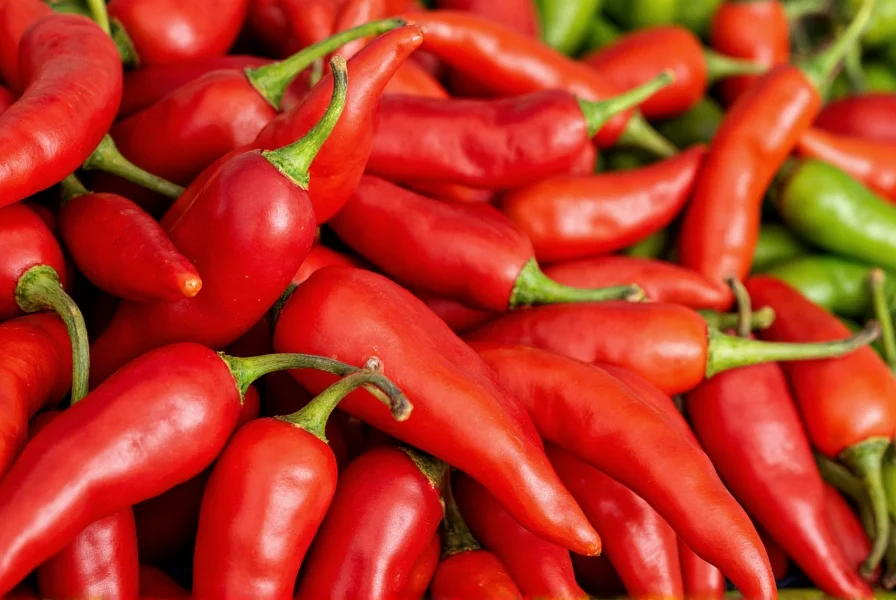Understanding red chili varieties is essential for both culinary enthusiasts and health-conscious consumers. These peppers span a remarkable spectrum of heat levels, measured on the Scoville scale from the mild 1,000 units of cherry peppers to the blistering 2,000,000+ units of Carolina Reapers. The diversity in flavor profiles—from sweet and fruity to smoky and intensely hot—makes red chilies indispensable in global cuisines.
| Chili Variety | Scoville Heat Units | Flavor Profile | Common Uses |
|---|---|---|---|
| Cayenne | 30,000-50,000 | Sharp, pungent | Spice blends, sauces, stir-fries |
| Thai Bird's Eye | 50,000-100,000 | Intense, citrusy | Thai and Vietnamese cuisine |
| Guajillo | 2,500-5,000 | Fruity, berry-like | Mexican moles, stews |
| Arbol | 15,000-30,000 | Nutty, woody | Salsas, hot sauces |
Exploring Red Chili Varieties and Their Characteristics
Red chilies transform from green to red as they mature, developing more complex flavors and often increasing in heat. The most common varieties include cayenne, which adds consistent heat to dishes without overwhelming other flavors; ancho chilies, which are dried poblanos offering a sweet, raisin-like flavor; and the intensely hot habanero, prized for its fruity notes despite its formidable heat level. When selecting fresh red chilies, look for firm, glossy skins without wrinkles or soft spots—indicating peak freshness and optimal flavor development.

Nutritional Benefits and Scientific Research
Red chili peppers deliver impressive nutritional value beyond their culinary appeal. A single red chili provides approximately 100% of the recommended daily vitamin C intake, surpassing even citrus fruits. Research published in the Journal of Agricultural and Food Chemistry confirms that capsaicin, the active compound in red chilies, may support metabolic health by increasing thermogenesis—the body's heat production process that burns calories. Additional studies suggest potential cardiovascular benefits, including improved blood circulation and reduced LDL cholesterol oxidation. The carotenoids responsible for the vibrant red color also function as powerful antioxidants that combat cellular damage.
Culinary Applications Across Global Cuisines
Professional chefs leverage red chilies to create distinctive flavor profiles in diverse culinary traditions. In Indian cooking, dried red chilies form the foundation of many spice blends, while in Chinese cuisine, whole dried chilies are briefly fried to infuse oils with subtle heat. Mexican cooks often toast dried red chilies before rehydrating them to develop deeper, smokier flavors for complex sauces. For home cooks exploring how to use red chili in cooking, consider these techniques: finely mince fresh chilies for salsas, roast whole peppers for Mediterranean dishes, or create infused oils by gently heating dried chilies in olive oil. Remember that seeds and white membranes contain the highest concentration of capsaicin, so remove them for milder heat.
Growing Your Own Red Chili Peppers
For gardeners interested in growing red chili peppers at home, these plants thrive in warm climates with at least 6-8 hours of direct sunlight daily. Start seeds indoors 8-10 weeks before the last frost, transplanting outdoors when soil temperatures exceed 70°F (21°C). Consistent watering is crucial—allow soil to dry slightly between waterings but avoid complete dryness. Most varieties require 70-90 days to mature from transplanting. Harvest peppers when they develop their characteristic deep red color and glossy sheen, though picking them earlier at the green stage won't harm the plant. Container gardening works well for many varieties, making red chilies accessible even to urban growers with limited space.
Safety Considerations and Handling Tips
When working with extremely hot red chili pepper varieties, proper handling prevents discomfort. Always wear gloves when cutting super-hot varieties like ghost peppers or Carolina Reapers, and avoid touching your face—especially eyes—during preparation. If skin irritation occurs, apply milk or yogurt to neutralize the capsaicin, as water merely spreads the oil. For those sensitive to spice, pair red chilies with dairy products like yogurt or cheese, which contain casein that breaks down capsaicin molecules. Individuals with gastrointestinal conditions should consult healthcare providers before significantly increasing chili consumption, as capsaicin may exacerbate certain digestive issues despite its potential benefits.
Frequently Asked Questions
What's the difference between fresh and dried red chilies?
Drying concentrates flavors and often intensifies heat in red chilies. Fresh chilies provide bright, grassy notes and higher moisture content, while dried versions develop deeper, smokier characteristics. Dried chilies typically have 10-15% of the water content of fresh peppers, making their capsaicin concentration more potent by weight. Rehydrating dried chilies in hot water for 20-30 minutes restores some moisture while preserving concentrated flavor.
How can I reduce the heat level of red chilies in cooking?
To reduce heat while preserving flavor, remove seeds and white membranes (placenta) where most capsaicin concentrates. Cooking chilies in fat-based liquids like coconut milk or olive oil helps distribute heat more evenly. Adding acidic components like lime juice or tomatoes can balance perceived heat. For extremely hot varieties, blanching in boiling water for 1-2 minutes before use significantly reduces spiciness without sacrificing flavor complexity.
Do red chilies lose nutritional value when cooked?
While vitamin C degrades with prolonged high-heat cooking, most other nutrients in red chilies remain stable. Capsaicin actually becomes more bioavailable when cooked with fats. Brief cooking methods like stir-frying preserve more nutrients than extended simmering. To maximize nutritional benefits, add chopped fresh red chilies during the final minutes of cooking or use dried chilies which retain most nutrients through the drying process.
Can I substitute one red chili variety for another in recipes?
Substitution requires understanding both heat level and flavor profile. For mild heat with similar flavor, replace cayenne with paprika (though paprika lacks significant heat). For Thai bird's eye chilies, serranos offer comparable heat with slightly different flavor notes. When substituting extremely hot varieties like habaneros, use only 1/4 to 1/2 the quantity of milder alternatives. Always taste as you go when experimenting with substitutions to achieve balanced results.










 浙公网安备
33010002000092号
浙公网安备
33010002000092号 浙B2-20120091-4
浙B2-20120091-4